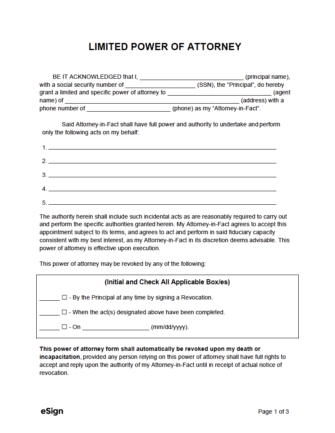Document Features
- Specific Acts – Grants the principal’s agent specific powers, which the principal can list in detail.
- Incapacitation – States that the agent’s powers automatically terminate when the principal is incapacitated.
- Revocation – Establishes a termination date when the agent’s powers will expire (aside from the principal’s incapacitation).
- Legitimacy – Secures the agent’s powers through signatures of the principal, the agent, and a notary public or witnesses.
By State
- Alabama
- Alaska
- Arizona
- Arkansas
- California
- Colorado
- Connecticut
- Delaware
- Florida
- Georgia
- Hawaii
- Idaho
- Illinois
- Indiana
- Iowa
- Kansas
- Kentucky
- Louisiana
- Maine
- Maryland
- Massachusetts
- Michigan
- Minnesota
- Mississippi
- Missouri
- Montana
- Nebraska
- Nevada
- New Hampshire
- New Jersey
- New Mexico
- New York
- North Carolina
- North Dakota
- Ohio
- Oklahoma
- Oregon
- Pennsylvania
- Rhode Island
- South Carolina
- South Dakota
- Tennessee
- Texas
- Utah
- Vermont
- Virginia
- Washington
- West Virginia
- Wisconsin
- Wyoming
Also Known As (AKA)
- LPOA
- Special Power of Attorney
- Specific Power of Attorney
- Temporary Power of Attorney
Common Uses
- Depositing or writing checks
- Signing legal documents
- Receiving mail
- Facilitating the purchase or sale of goods
- Business, financial, or real estate management
Sample
Download: PDF (Blank) | PDF (Sample Data)
BE IT ACKNOWLEDGED that I, [PRINCIPAL NAME], with a social security number of [#], the “Principal,” do hereby grant a limited and specific power of attorney to [AGENT NAME] of [AGENT ADDRESS] with a phone number of [AGENT PHONE NUMBER] as my “Attorney-in-Fact.”Said Attorney-in-Fact shall have full power and authority to undertake and perform only the following acts on my behalf: [DESCRIBE POWERS]
This Power of Attorney form shall automatically be revoked and terminate when the acts designated above have been completed or on [MM/DD/YYYY].
This Power of Attorney form shall automatically be revoked upon my death or incapacitation, provided any person relying on this power of attorney shall have full rights to accept and reply upon the authority of my Attorney-in-Fact until in receipt of actual notice of revocation.
This Power of Attorney is governed by the laws of the State of [STATE NAME].
Signed on [MM/DD/YYYY].
________________________________
Principal’s Signature
[PRINCIPAL PRINTED NAME]
ACCEPTANCE OF APPOINTMENT
I, [ATTORNEY-IN-FACT NAME], the Attorney-in-Fact named above, hereby accept appointment as Attorney-in-Fact in accordance with the foregoing instrument.
________________________________
Attorney-in-Fact’s Signature
[ATTORNEY-IN-FACT PRINTED NAME]
WITNESSES
________________________________
Witness Signature
[PRINTED NAME] [WITNESS ADDRESS]
________________________________
Witness Signature
[PRINTED NAME] [WITNESS ADDRESS]
ACKNOWLEDGMENT OF NOTARY PUBLIC
STATE OF [STATE]
COUNTY [COUNTY]
On [MM/DD/YYYY], before me appeared [PRINCIPAL NAME], as Principal of this Power of Attorney, who proved to me through government-issued photo identification to be the above-named person, in my presence executed the foregoing instrument and acknowledged that he executed the same as his free act and deed.
_________________________________________
Notary Public
My commission expires: [EXPIRATION]
How to Use a Limited POA
Step 1 – Decide the Powers to Give
The principal must decide the powers they would like to give to the agent and which authorizations may be needed for them to fulfill their purpose. The powers cannot relate to health care decisions.
Step 2 – Select the Agent
Also known as an “attorney-in-fact,” the agent is the person who will have the authorization to handle requests on the principal’s behalf. The principal usually chooses a person they know well and trust, such as a:
- Family member (spouse, child, parent, etc.).
- Close friend.
- Legal or financial professional.
Step 3 – Complete the Form
The limited POA must be drafted in accordance with state laws and list the names and addresses of the principal and agent. The form must define the agent’s powers and state that they are not durable and will become void upon the principal’s incapacity.
Expiration – Limited power of attorney documents should have an expiration date or an event that triggers the revocation of the form.
Step 4 – Sign the Form
A limited power of attorney must be signed in accordance with the state’s signing requirements.
Typically, a notary public must observe the document’s signing for it to be valid. Witnesses may also be required or recognized as an alternative to notarization.
Step 5 – Give the POA to the Agent
Once signed by all required parties, a copy of the POA must be given to the agent.
Most institutions and organizations will demand the POA before allowing the agent to act in the principal’s name. In some cases, they may require further proof of authorization and identity.






